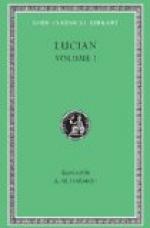For two years they were able to withstand the Spanish invaders in their “casas-grandes.” It had been reported to the Spanish commanders that several hundred miles in the north lay a great empire named Cibola, which had seven large cities. In these were long streets, on which only gold and silversmiths resided; imposing palaces towered in the suburbs, with doors and columns of pure turquoise; the windows were made of precious stones brilliantly polished. At the sumptuous feasts of the prince of the land, enchanting slaves served the most delicate dainties on golden dishes. There were mountains of opal rising above valleys reveling in jewels, with crystal streams, whose bottom consisted of pure silver sand.
The disappointment of the Spaniards was great. A number of large Indian villages were found, whose inhabitants subsisted upon the fruits of a primitive agriculture. The frugality and thrift of the Pueblos excited the interest of the voluptuous Spaniards. The peculiar architecture of the villages and houses also drew their admiration. Taken as a whole, the circles of houses resembled the cells of a wasp’s nest, of which the upper stories were reached on a crude ladder. Entrance could be gained only through a small opening in the roof, not even the sides facing the streets containing doors. A few heavily grated windows served as port-holes for their arrows. These peculiar constructions of baked clay are still fashionable in such old towns as Suni, Taos and others.
Situated as the Moqui villages and Acoma were, on the top of an inaccessible rock, the Spaniards despaired of conquering them. The supposed Cibola not panning out according to expectation, they did not seek reinforcement, and left the Pueblos in peace. Only near the end of the Sixteenth Century the Pueblos had to submit to Spanish rule, under which they remained until 1848, when the territory embracing New Mexico and Arizona was ceded to the United States.
In some respects the Spanish supremacy proved beneficial to the Indians. They virtually maintained their independence. Many innovations in their life and customs can be traced from this period. The only domestic creatures in their villages were large turkeys, whose feathers served as head ornaments for the warriors; but horses, cows, sheep, goats, dogs and last, but not least, the indispensable burros were added to their domestic stock.
The most important change in their communistic mode of living dates from the annexation of New Mexico to the United States, and the introduction of railroads. Their unfriendly neighbors, the Apaches, Comanches, Kiowas and Navajos, were restricted to their own reservations.
Feeling safe under the powerful protection of the Government, these peaceable people have begun to relinquish their old mode of communistic existence in their strange dwellings. Until recently, there was a promiscuous living together of large families in the numerous apartments of a single house, to which access could be only obtained through a small aperture in the roof. More modern cottages are being built for single families now; farming is also carried on on a large scale, and in some parts grape and fruit culture is attempted with good results.




